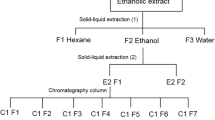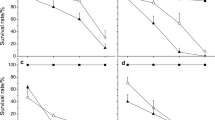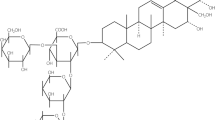Abstract
Pomacea canaliculata is an invasive snail that can adversely affect biodiversity, agricultural crop yields and human health. Schima superba, which belongs to the Theaceae family, exhibits insecticidal and antibacterial activity, but few studies have focused on its potential molluscicidal activity. In this study, we systematically evaluated the molluscicidal activity of S. superba extract against P. canaliculata in a variety of conditions, including multiple exposure intervals (24, 48 and 72 h), temperatures (15, 20 and 25 °C) and shell diameters (1.5 ± 0.2, 2.5 ± 0.2 and 3.5 ± 0.2 cm). The molluscicidal activities of a 10% microemulsion of S. superba extract were tested on rice in plastic pots filled with mud at different exposure intervals (1, 3, 5 and 7 days). In addition, we isolated and purified the active components from S. superba extract and described them. S. superba was highly toxic to P. canaliculata; the LC50 values for the crude extract at 72 h were 12.25 mg L−1 (15 °C), 11.31 mg L−1 (20 °C), 8.33 mg L−1 (25 °C) with 2.5 ± 0.2 cm shell diameter and 9.43 mg L−1 (1.5 ± 0.2 cm shell diameter), 9.48 mg L−1 (2.5 ± 0.2 cm shell diameter), 10.06 mg L−1 (3.5 ± 0.2 cm shell diameter) at 25 °C. There was a positive correlation between the molluscicidal activity of the extract and treatment temperature after 24 h of treatment, but there was no clear correlation beyond 24 h. In addition, there was no statistically significant correlation between the molluscicidal activity of the extract and shell diameters. Pot trials showed that the crude extract effectively controlled P. canaliculata at 8 and 10 mg L−1. We isolated and characterized two pentacyclic triterpenoid saponins from S. superba, maetenoside B and sasanquasaponin III, which had high molluscicidal activity. This study provides an important foundation for future research on the potential value of S. superba as a molluscicide.




Similar content being viewed by others
References
Archibald RG (1933) The use of the fruit of Balanites ægyptiaca in the control of schistosomiasis in the Sudan. Trop Med Hyg 27:207–210. doi:10.1016/S0035-9203(33)90011-5
Attademo AM, Lajmanovich RC, Peltzer PM, Junges CM (2016) Acute toxicity of metaldehyde in the invasive rice snail Pomacea canaliculata and sublethal effects on tadpoles of a non-target species (Rhinella arenarum). Water Air Soil Pollut 227:400. doi:10.1007/s11270-016-3083-9
Baptista DF, Vasconcellos MC, Lopes FE, Silva IP, Schall VT (1994) Perspectives of using euphorbia splendens as a molluscicide in schistosomiasis control programs. Southeast Asian J Trop Med Public Health 25:419–424
Dai LP, Luo WH, Wang WX (2011) Molluscicidal efficacy of Nerium indicum cardiac glycosides on Pomacea canaliculata and its effects on rice seedling. Acta Ecol Sin 31:1918–1924
Deng ZY (2013) The inhibitory effects of the extracts from Schima superba on the growth of plutella xylostella and Pieris rapae. Jiangsu Agric Sci 4:129–130
Deng ZY, Deng YC, Liu YH (2007) Antifeedant activities of the extracts from Schima superba against plutella xylostella and Pieris rapae. Agrochemicals 12:854–856
Deng ZY, Deng YC, Zhou GY (2010) Tracing insecticidal ingredients from barks of Schima superba. Agrochemicals 8:612–614
Feng HG, Zhang CL, Huo GH (2012) The separation of active ingredients from Schima superba and the toxicity to Pyricularia oryzae Cav. Jiangsu Agric Sci 4:114–117
Fu XY, Wang HQ (1999) The effects of temperature on growth and development of Pomacea canaliculata. J Fish China 23:21–26
Hallett KC, Atfield A, Comber S, Hutchinson TH (2015) Development toxicity of metaldehyde in the embryos of lymnaea stagnails (Gastropoda: pulmonate) co-exposed to the synergist piperonyl butoxide. Sci Total Environ 543:37–43
Huo GH, Zhan WG, Chen MH (2008) The anti-fungal activities of Schima superba and Camellia oleifera Abel from Theaceae against pathogen such as Pyricularia oryzae Cav. Acta Agric Univ Jiangxiensis 1:48–52
Jiang WB, Yang GM (2006) The tendency of occurrence of Ampullarial gigas Spix and prevent & control countermeasures. J Guangxi Agric 21:23–25
Karraker NE, Dudgeon D (2014) Invasive apple snails (Pomacea canaliculata) are predators of amphibians in south China. Biol Invasions 16:1785–1789. doi:10.1007/s10530-014-0640-2
Kloos H, McCullough FS (1987) Plants with recognized molluscicidal activity. Plant Molluscic 45:31
Koike K, Jia Z, Nikaido T (2001) New triterpenoid saponins from Maesa tenera. Chem Pharm Bull (Tokyo) 49:758–761. doi:10.1248/cpb.49.758
Li ZM, Liu ZG, Xu FJ, He NX, Yang RW (2011) Effects of body weight, temperature and salinity on oxygen consumption and ammonia excretion rates of Meretrix lyrata. Adv Mar Sci 29:512–520
Liu YB, Han W, Xian ZH (2011) Effect of different temperatures on growth, development and feeding of Pomacea canaliculata. J Southern Agric 42:901–905
Matsuda H, Nakamura S, Fujimoto K, Moriuchi R, Kimura Y, Ikoma N, Hata Y, Muraoka O, Yoshikawa M (2010) Medicinal Flowers. XXXI. Acylated oleanane-type triterpene saponins, Sasanquasaponins I-V, with antiallergic activity from the flower buds of Camellia sasanqua. Chem Pharm Bull 58:1617–1621
Nechepurenko IV, Polovinka MP, Komarova NI, Korchagina DV, Salakhutdinov NF, Nechepurenko SB (2008) Low-molecular-weight phenolic compounds from Hedysarum theinum roots. Chem Nat Compd 44:31–34. doi:10.1007/s10600-008-0009-9
Palis FV, Macatula RF, Browning L (1997) Bayluscide 250 EC (Niclosamide), an effective molluscicide for the golden apple snail (Pomacea canaliculata Lamarck) control in the Philippine rice production system. Philipp J Crop Sci 22:41
Pan YY, Dong SZ, Yu XP (2008) Effects of temperature stress on development, feeding and survival of the apple snail, Pomacea canaliculata (Lamarck). Acta Phytophylacica Sin 35:239–244
Shoaib MA, Mahmoud MF, Loutfy N, Tawfic MA, Barta M (2010) Effect of botanical insecticide Nimbecidine on food consumption and egg hatchability of the terrestrial snail Monacha obstructa. J Pest Sci 83:27–32. doi:10.1007/s10340-009-0265-x
Sousa RMOF, Rosa JS, Silva CA, Almeida MTM, Novo MT, Cunha AC, Fernandes-Ferreira M (2015) Larvicidal, molluscicidal and nematicidal activities of essential oils and compounds from Foeniculum vulgare. J Pest Sci 88:413–426. doi:10.1007/s10340-014-0628-9
Stark T, Bareuther S, Hofmann T (2005) Sensory-guided decomposition of roasted cocoa nibs (theobroma cacao) and structure determination of taste-active polyphenols. J Agric Food Chem 53:5407–5418. doi:10.1021/jf050457y
Takougang I, Meli J, Wabo Poné J, Angwafo F (2007) Community acceptability of the use of low-dose niclosamide (bayluscide), as a molluscicide in the control of human schistosomiasis in Sahelian Cameroon. Ann Trop Med Parasitol 101:479–486. doi:10.1179/136485907X193833
Tuo Y, Zeng XN, Ju JH, Zhang S, Wu S (2005) Molluscidal activity of the methanol extracts of 40 species of plants. Plant Prot 31:31–34
Wang ZG, Tan JC, Liu J, Wang W (2011) Evaluation of the controlling Pomacea canaliculata with calcium oxide, ammonium bicarbonate, Camellia oleifera powder and tea saponin. Acta Phytophylacica Sin 38:363–368
Xian ZH, Jia DT, Han W (2012) Effect of tea saponin on growth of apple snail (Pomacea canaliculata) at different developmental stages. J South Agric 43:1129–1134
Xu W (2009) Research on the chemical composition of Schima superba. Dissertation, Jinan University
Yan WF (2013) The occurrence, damage and control technology of Pomacea canaliculata. Fujian Agric 5:29
Yin FP, Jia XB (2016) Control effect of 4% TDS DP against Pomacea canaliculata. Pestic Sci Admin 37:54–56
Zhang CL (2011) Isolation and identification of the saponins from Schima superba with resisting Magnaporthe oryzae Cav. activity. Dissertation, Jiangxi Agricultural University
Zhang JE, Fang L (2008) Ecological issues of research for biological invasion of Ampullaria gigas Spix in China. Chin J Eco Agric 16:1585–1589
Zhong F (2015) Research progress on the control of Pomacea canaliculata in China. World Pestic 37:21–24
Author information
Authors and Affiliations
Corresponding author
Ethics declarations
Conflict of interest
All authors declare that they have no conflict of interest.
Ethical approval
This article does not contain any studies with animals performed by any of the authors.
Additional information
Communicated by M.B. Isman.
Rights and permissions
About this article
Cite this article
Yang, C., Chang, X., Zhang, M. et al. Active compounds of stem bark extract from Schima superba and their molluscicidal effects on Pomacea canaliculata . J Pest Sci 91, 437–445 (2018). https://doi.org/10.1007/s10340-017-0848-x
Received:
Revised:
Accepted:
Published:
Issue Date:
DOI: https://doi.org/10.1007/s10340-017-0848-x




